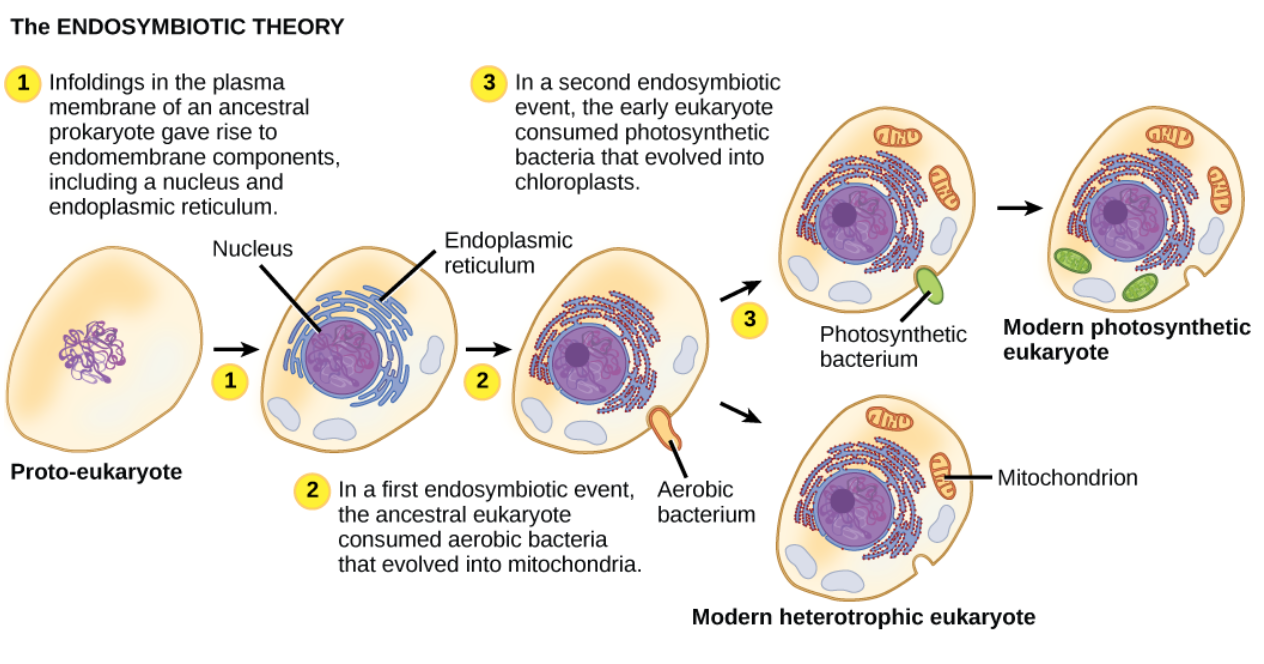2.11 Origins of Cell Compartmentalization
2 min read•november 18, 2024
Caroline Koffke
Haseung Jun
Caroline Koffke
Haseung Jun
Skills you’ll gain in this topic:
- Explain the endosymbiotic theory for the origins of mitochondria and chloroplasts.
- Describe evidence supporting endosymbiosis, like organelle DNA and double membranes.
- Connect compartmentalization to evolutionary advantages in eukaryotes.
- Analyze the significance of endosymbiosis in cellular evolution.
- Predict how compartmentalization contributes to increased complexity in organisms.
Prokaryotic Cells
Prokaryotic cells are small cells that simply have a ring of circular DNA floating inside the cell. These small, tiny cells are believed to the earliest forms of life found on Earth. Even 4 billion years ago, prokaryotes existed on earth. Eukaryotic cells, on the other hand, only appeared 1.8 billion years ago. Most biologists think the ancestor of eukaryotic cells are prokaryotic cells. But eukaryotic cells are much more complex than prokaryotic cells. Eukaryotic cells also have a mitochondrion, unlike prokaryotic cells.
Endosymbiotic Theory
Ever wonder why we have mitochondria in our cells but the mitochondrion has its own membrane? The endosymbiotic theory is the current theory of how eukaryotic membrane-bound organelles existed in eukaryotic cells. The endosymbiotic theory states that an early ancestor of eukaryotic cells engulfed a prokaryotic cell, and the prokaryotic became an endosymbiont, a cell living in another cell.
These smaller cells were capable of producing extra energy for the other cell, leading to a selective advantage. Overtime, cells with an extra cell inside were able to become more able to survive and reproduce quickly. Then the eukaryotic cell was born! While prokaryotes generally lack internal membrane bound organelles, they still have internal regions with specialized structures and functions. These regions are just not defined by outer membranes. The cell wall plays a key role in keeping the prokaryotic cells
Evidence
There is quite a bit of evidence to support this claim. In 1883, a botanist named Andreas Schimper discovered that plastids divided just like bacteria did. During the 1950s and 60s, many biologists found that mitochondria and plastids had their own DNA. They even found that the DNA was more like those of prokaryotes rather than eukaryotes. The mitochondrion even had its own membrane, which is what a free-living cell would have.
This makes us conclude that the mitochondrion was once a prokaryote.

<< Hide Menu
2.11 Origins of Cell Compartmentalization
2 min read•november 18, 2024
Caroline Koffke
Haseung Jun
Caroline Koffke
Haseung Jun
Skills you’ll gain in this topic:
- Explain the endosymbiotic theory for the origins of mitochondria and chloroplasts.
- Describe evidence supporting endosymbiosis, like organelle DNA and double membranes.
- Connect compartmentalization to evolutionary advantages in eukaryotes.
- Analyze the significance of endosymbiosis in cellular evolution.
- Predict how compartmentalization contributes to increased complexity in organisms.
Prokaryotic Cells
Prokaryotic cells are small cells that simply have a ring of circular DNA floating inside the cell. These small, tiny cells are believed to the earliest forms of life found on Earth. Even 4 billion years ago, prokaryotes existed on earth. Eukaryotic cells, on the other hand, only appeared 1.8 billion years ago. Most biologists think the ancestor of eukaryotic cells are prokaryotic cells. But eukaryotic cells are much more complex than prokaryotic cells. Eukaryotic cells also have a mitochondrion, unlike prokaryotic cells.
Endosymbiotic Theory
Ever wonder why we have mitochondria in our cells but the mitochondrion has its own membrane? The endosymbiotic theory is the current theory of how eukaryotic membrane-bound organelles existed in eukaryotic cells. The endosymbiotic theory states that an early ancestor of eukaryotic cells engulfed a prokaryotic cell, and the prokaryotic became an endosymbiont, a cell living in another cell.
These smaller cells were capable of producing extra energy for the other cell, leading to a selective advantage. Overtime, cells with an extra cell inside were able to become more able to survive and reproduce quickly. Then the eukaryotic cell was born! While prokaryotes generally lack internal membrane bound organelles, they still have internal regions with specialized structures and functions. These regions are just not defined by outer membranes. The cell wall plays a key role in keeping the prokaryotic cells
Evidence
There is quite a bit of evidence to support this claim. In 1883, a botanist named Andreas Schimper discovered that plastids divided just like bacteria did. During the 1950s and 60s, many biologists found that mitochondria and plastids had their own DNA. They even found that the DNA was more like those of prokaryotes rather than eukaryotes. The mitochondrion even had its own membrane, which is what a free-living cell would have.
This makes us conclude that the mitochondrion was once a prokaryote.


© 2025 Fiveable Inc. All rights reserved.